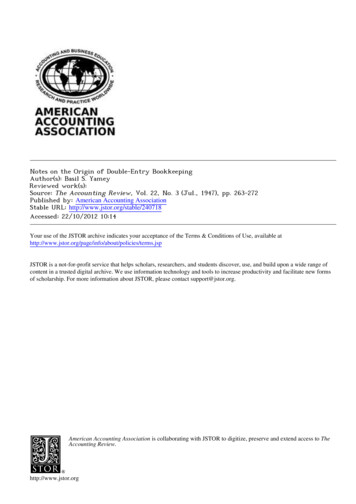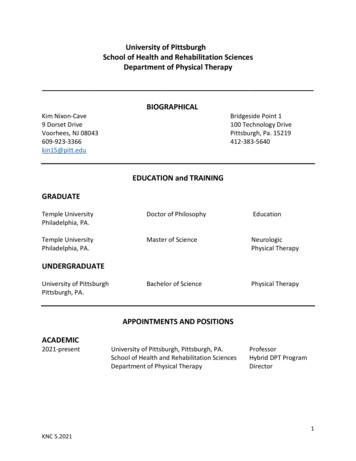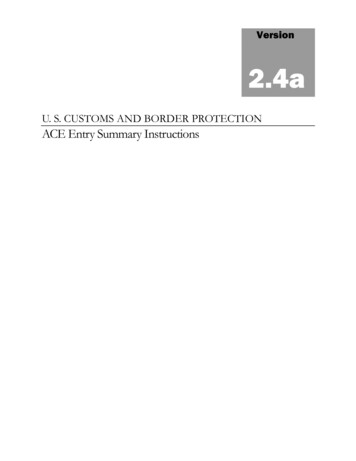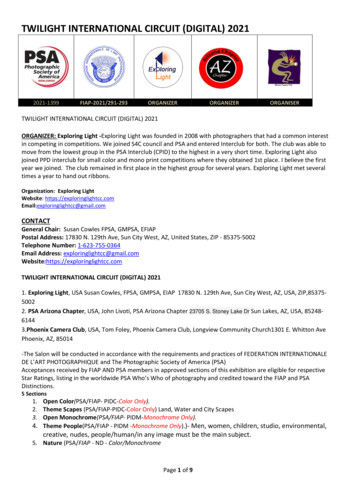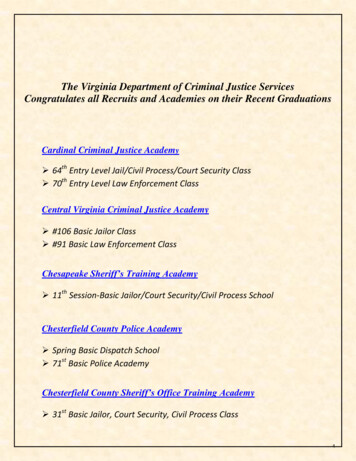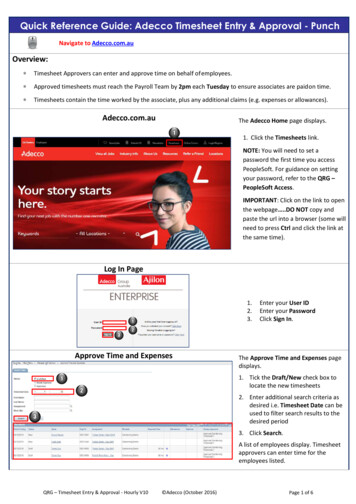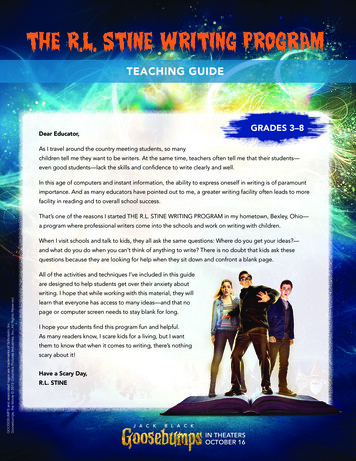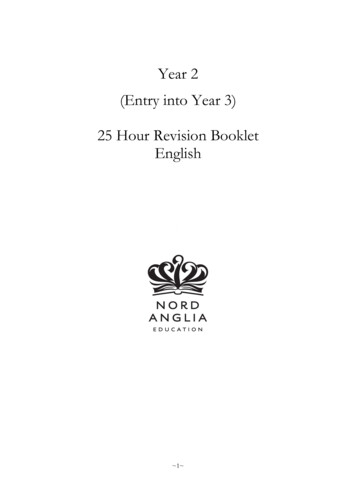
Transcription
Year 2(Entry into Year 3)25 Hour Revision BookletEnglish 1
This page has been intentionally left blank 2
SummaryThe activities for English are intended to provide scaffolding and support for pupils, developingknowledge, understanding, and skills as they progress through the booklets. While the activities areindeed labelled as 'comprehension' or 'composition' tasks, these vary significantly as they progress,and build upon knowledge and skills conveyed in earlier stages of each booklet.All booklets have been developed in line with curriculum content from the 'Department ofEducation English Programme of Study for Key Stage 1 and 2 of the National Curriculum inEngland'.In all cases the work has been structured to build upon what has been addressed in previoussections of each booklet, ensuring that pupils develop both skills and understanding as they progress.Where tasks have been repeated, the content has been changed to ensure on-going interest,while reinforcing knowledge and skills.This booklet aims to combine what should have been learnt in Year 2 and what pupils canexpect to learn in year 3. There are more comprehension and composition tasks in this booklet dueto the need for 'teaching comprehension [to take] precedence over teaching word reading directly' asset out in the National Curriculum.The 'Use of English' sections deal with homophones; spelling, including the silent 'k' and 'c'with an 's' sound; apostrophes - specifically contractions and possessive apostrophes; and commonsuffixes. All of these 'Use of English' tasks are based on the recommendations set forth in theNational Curriculum guidelines for English for Year 2 to Year 3.The five final comprehension and composition questions are aimed at both 'increasing(pupils) familiarity with a wide range of books, including fairy stories, myths and legends, andretelling some of these orally and identifying themes and conventions in a wide range of books.' - asset out in the National Curriculum guidelines. At this stage it is important that pupils are exposed toa wide range of simple literary texts and encouraged to respond to them creatively. Thecomprehension questions seek to encourage pupils to start visualizing the story scene with the use of'draw a picture' tasks, and to start engaging critically by finding information from a text. Thecomposition tasks are carefully structured so that pupils are guided through each step of every task. 3
Comprehension and Composition 1Learning ObjectiveThis section is designed to challenge pupils’ comprehension skills to grow beyond simple‘direct word reading’. Further lessons are given in homophone identification and use, andfinally a section on comprehension is designed to give children a chance to develop theirwriting skills and knowledge.Comprehension Task – 1 HourRead the extract from Nonsense Books below, andanswer the questions. 4
Nonsense Books by Edward Lear. 5
Read the story above carefully and then answer thequestions. Remember to write your answers in fullsentences, taking care with spelling and punctuation. 6
7
8
9
Use of EnglishTypes of Writing – 1 hourHomophonesHomophones are words that sound the same but have adifferent spelling and meaning.Underline the correct word in each sentence, e.g. 10
Use these homophone pairs and write sentences ofyour own, e.g. 1. We won the football. 2. I have onecar.Homophone Pair 1Homophone Pair 2Homophone Pair 3 11
Homophone Pair 4Homophone Pair 5 12
Homophone Pair 6 13
Composition Task – 1 HourIf you went on a long journey by boat what wouldyou take with you? 14
Who would you take with you? Why? 15
Draw a picture of the boat you would like to travel inand all the things you would like to take. Draw yourpicture in the box below. 16
Comprehension and Composition 2Learning ObjectiveBuilding on previous lessons, comprehension and composition skills are further challengedhere, and later sections deal with the use of the silent ‘k’ and soft ‘c’ in the English language.Comprehension Task – 1 HourRead the extract from Goody Two Shoes below, andanswer the questions. 17
18
Read the passage above carefully and then answerthe questions. Remember to write your answers infull sentences, taking care with spelling andpunctuation. 19
20
21
22
23
Use of EnglishSpelling – 1 hourThe silent 'k'Look at the following words, how do you say them?The 'k' in all these words is silent, instead it is pronounced 'n'.PracticeChoose one of the five words above to put into thesesentences. 24
Find two more words that have a silent 'k' at thebeginning and sound like 'n'.The 's' sound with a 'c'The 's' sound spelt with a 'c' usually comes before the letters 'e','i' and 'y'.Look at the following words, how do you say them? 25
Choose one of the five words above to put into thesesentences.Find two more words that have an 's' sound spelledwith a 'c'. 26
Composition Task – 1 HourHow did you learn your alphabet? Did your teacheruse cards, or did you have to write it out? 27
Describe your favourite teacher. Why is he/she yourfavourite teacher? 28
Describe your classroom. Is it big or small? Do youhave tables and a whiteboard? Are there pictures onthe walls? 29
Draw and label a picture of your classroom in thebox below. Remember to include all the details thatyou remember. 30
Comprehension and Composition 3Learning ObjectiveComprehension and composition skills are further challenged here, followed by a section onthe use of apostrophes in contractions.Comprehension Task – 1 HourRead the story from A-Apple Pie and Other NurseryTales below, and answer the questions. 31
Read the passage above carefully and then answerthe questions. Remember to write your answers infull sentences, taking care with spelling andpunctuation. 32
33
34
Use of EnglishPunctuation – 1 hourApostrophes – ContractionsApostrophes can be used to make two words into one, e.g.Look at these contracted words and write them outin full, e.g. I've I have 35
36
Look at the text below.You are given twoalternatives, underline the correct contraction.Write about a time when you didn't get your ownway. Use at least five contractions in your writing. 37
38
Composition Task – 1 HourCan you remember any fairytales? Write down thenames of the fairytales you remember. 39
What characters do fairytales usually have? E.g.Giants, witches etc. 40
Choose one fairytale that you remember really well.Write a summary of the fairytale on the lines below. 41
Write a fairytale of your own. Begin, ‘once upon atime ’ 42
Comprehension and Composition 4Learning ObjectiveComprehension and composition tasks, building on previous sections, give pupils furtheropportunities to practice and develop their skills beyond ‘word reading’ in this section, inaddition to a section on the use of possessive apostrophes.Comprehension Task – 1 HourRead the story from The Red Fairy Book below, andanswer the questions. 43
The Red Fairy Book, Andrew Lang 44
Read the passage above carefully and then answerthe questions. Remember to write your answers infull sentences, taking care with spelling andpunctuation. 45
46
47
48
Use of EnglishPunctuation – 1 hourPossessive ApostrophesWe use apostrophes to show that something belongs tosomeone.e.g., The man's car.Look at the following sentences.correct word. 49 Underline the
Think about something you best friend owns. Writeabout it using four possessive apostrophes. Writeyour answer on the lines below. 50
Look at the following sentences. Re-arrange them sothat they contain a possessive apostrophe. E.g. Theroom that belongs to Susie Susie's room. 51
52
Composition Task – 1 HourWhat kinds of things do you dream about? Write alist on the lines below. 53
In the story 'The Red Fairy' Michael has a dream. Isthis a good dream or a bad dream? Why? You canread the story again to decide. 54
What happens next in the story? Continue the storyon the lines below. 55
Comprehension and Composition 5Learning ObjectiveChallenging pupils further, these comprehension and composition sections ask pupils torespond creatively to the Aesop’s Fable, in addition to a section on the identification and use ofsuffixes in the English language.Comprehension Task – 1 HourRead the story from Aesop's Fables below, andanswer the questions. 56
.The Wolf and the Crane, Aesop's Fables, Aesop. 57
Read the passage above carefully and then answerthe questions. Remember to write your answers infull sentences, taking care with spelling andpunctuation. 58
59
60
Use of EnglishSpelling – 1 hourSuffixes'ment' is sometimes added to words to make nouns, e.g. enjoy ment enjoyment.Add the suffix 'ment' to the following words. E.g.,entertain ment entertainment 61
62
Use these suffixed words to make your ownsentences. 63
64
'ness' is sometimes added to words to make nouns, e.g. happy ness happinessAdd the suffix 'ness' to the following words. E.g.sad ness sadness 65
66
Use these suffixed words to make your ownsentences. 67
68
Composition Task – 1 HourWhat type of animals live in the forest? Write a list onthe lines below. 69
Pick two of the animals on your list. Imagine theymet each other in the forest. What might they say?Write ideas on the lines below. 70
Write a script. Include the two animals that you havechosen.Set it out like this: 71
72
Comprehension and Composition 6Learning ObjectiveThese sections are aimed at both 'increasing (pupils) familiarity with a wide range of books,including fairy stories, myths and legends, and retelling some of these orally and identifyingthemes and conventions in a wide range of books.' - as set out in the National Curriculumguidelines. Pupils are exposed to a wide range of simple literary texts and encouraged torespond to them creatively. The comprehension questions seek to encourage pupils to startvisualizing the story scene with the use of 'draw a picture' tasks, and to start engaging criticallyby finding information from a text. The composition tasks are carefully structured so thatpupils are guided through each step of every task. Each section builds on earlier lessons andchallenges to develop pupils’ skills.Comprehension Task – 1 HourRead the story from Grimm’s' Fairy Stories below,and answer the questions. 73
Grimm's Fairy Stories, Jacob Grimm and Wilhelm Grimm 74
Read the passage above carefully and then answerthe questions. Remember to write your answers infull sentences, taking care with spelling andpunctuation. 75
76
77
Composition Task – 1 HourHave you ever been alone in an unknown place, likethe children in the story? If so, how did it feel? Ifnot, how do you imagine it must feel? 78
What will their stepmother, the wicked witch do tothe children? Use your imagination to help you.Write your thoughts down on the lines below. 79
Imagine you are the wicked witch. Why does shedislike the children so much? Does she have a goodreason?Write your thoughts using first person narrative 'I'. 80
81
Comprehension and Composition 7Learning ObjectiveThese sections are aimed at both 'increasing (pupils) familiarity with a wide range of books,including fairy stories, myths and legends, and retelling some of these orally and identifyingthemes and conventions in a wide range of books.' - as set out in the National Curriculumguidelines. Pupils are exposed to a wide range of simple literary texts and encouraged torespond to them creatively. The comprehension questions seek to encourage pupils to startvisualizing the story scene with the use of 'draw a picture' tasks, and to start engaging criticallyby finding information from a text. The composition tasks are carefully structured so thatpupils are guided through each step of every task. Each section builds on earlier lessons andchallenges to develop pupils’ skills.Comprehension Task – 1 HourRead the story from Mother Goose in Prose below,and answer the questions. 82
Mother Goose in prose by L. Frank Baum 83
Read the passage above carefully and then answerthe questions. Remember to write your answers infull sentences, taking care with spelling andpunctuation. 84
85
86
Composition Task – 1 HourDo you play a musical instrument or like listening tomusic? Write about the music that you like. 87
If you were left at home alone like Bobby what wouldyou do? Write your thoughts on the lines below. 88
Write the next part of the story. Try to include whatBobby does when his parents are away and whathappens when they come back home. 89
90
Comprehension and Composition 8Learning ObjectiveThese sections are aimed at both 'increasing (pupils) familiarity with a wide range of books,including fairy stories, myths and legends, and retelling some of these orally and identifyingthemes and conventions in a wide range of books.' - as set out in the National Curriculumguidelines. Pupils are exposed to a wide range of simple literary texts and encouraged torespond to them creatively. The comprehension questions seek to encourage pupils to startvisualizing the story scene with the use of 'draw a picture' tasks, and to start engaging criticallyby finding information from a text. The composition tasks are carefully structured so thatpupils are guided through each step of every task. Each section builds on earlier lessons andchallenges to develop pupils’ skills.Comprehension Task – 1 HourRead the story from The Wind in The Willows below,and answer the questions. 91
The Wind in the Willows, Kenneth Grahame 92
Read the passage above carefully and then answerthe questions. Remember to write your answers infull sentences, taking care with spelling andpunctuation. 93
94
95
Composition Task – 1 HourIs there anyone you would really like to meet i.e., anactor singer etc.?Write a list of people you'd like to meet and why youwould like to meet them. 96
Imagine that Mole meets the Badger. What wouldthey say to each other? Write a conversation thatmight take place between them. 97
98
Comprehension and Composition 9Learning ObjectiveThese sections are aimed at both 'increasing (pupils) familiarity with a wide range of books,including fairy stories, myths and legends, and retelling some of these orally and identifyingthemes and conventions in a wide range of books.' - as set out in the National Curriculumguidelines. Pupils are exposed to a wide range of simple literary texts and encouraged torespond to them creatively. The comprehension questions seek to encourage pupils to startvisualizing the story scene with the use of 'draw a picture' tasks, and to start engaging criticallyby finding information from a text. The composition tasks are carefully structured so thatpupils are guided through each step of every task. Each section builds on earlier lessons andchallenges to develop pupils’ skills.Comprehension Task – 1 HourRead the story from The Book of Dragons below,and answer the questions. 99
The Book of Dragons, E. Nesbit 100
Read the passage above carefully and then answerthe questions. Remember to write your answers infull sentences, taking care with spelling andpunctuation. 101
102
103
104
Composition Task – 1 HourWhat does the word 'curious' mean? If you are notsure, look it up in a dictionary and write it down inthe space below. 105
Write a story about something 'curious' but firstspend ten minutes planning your story on the linesbelow. Think about the characters, the setting andwhat will happen. 106
107
Now write your story, with the title, 'SomethingCurious'. 108
109
Comprehension and Composition 10Learning ObjectiveThese sections are aimed at both 'increasing (pupils) familiarity with a wide range of books,including fairy stories, myths and legends, and retelling some of these orally and identifyingthemes and conventions in a wide range of books.' - as set out in the National Curriculumguidelines. Pupils are exposed to a wide range of simple literary texts and encouraged torespond to them creatively. The comprehension questions seek to encourage pupils to startvisualizing the story scene with the use of 'draw a picture' tasks, and to start engaging criticallyby finding information from a text. The composition tasks are carefully structured so thatpupils are guided through each step of every task. Each section builds on earlier lessons andchallenges to develop pupils’ skills. 110
Comprehension Task – 1 HourRead the extract from London Town below, andanswer the questions.London Town, Thomas Crane, Ellen Houghton 111
Read the poem ‘The Penny Ice Man’ carefully andthen answer the questions. Remember to write youranswers in full sentences, taking care with spellingand punctuation. 112
113
114
Composition Task – 1 HourImagine that you could live in an ice cream parlour.What would it look like, what ice-cream flavourswould you sell? 115
Who would you invite to your ice cream parlour?Make a list on the lines below. 116
Draw a picture of your ice-cream parlour in the boxbelow. Add labels to show details. 117
Education English Programme of Study for Key Stage 1 and 2 of the National Curriculum in England'. In all cases the work has been structured to build upon what has been addressed in previous sections of each booklet, ensuring that pupils develop both skills and understanding as they progress.

